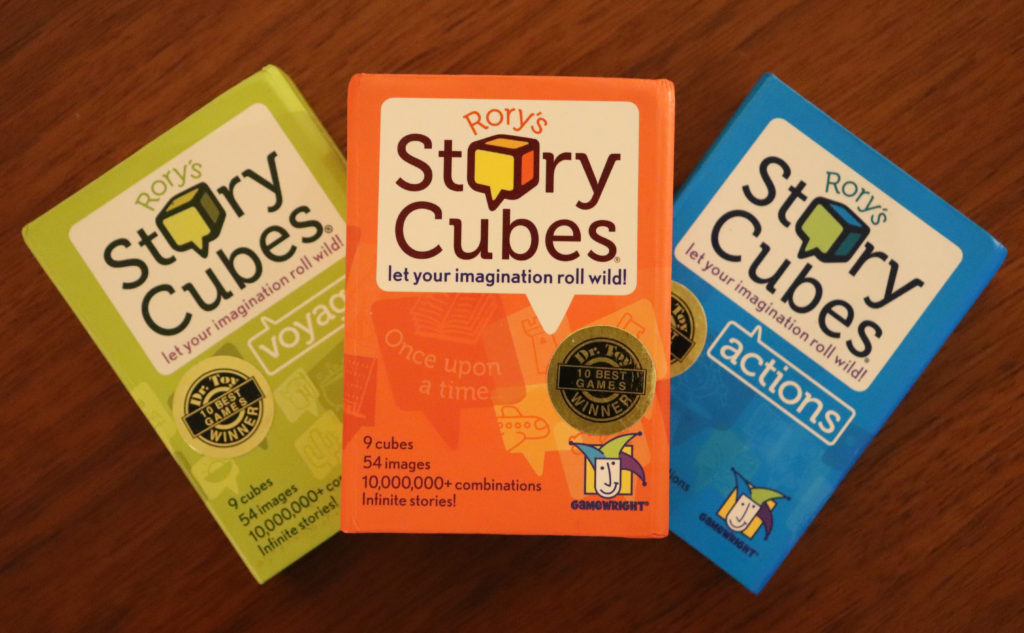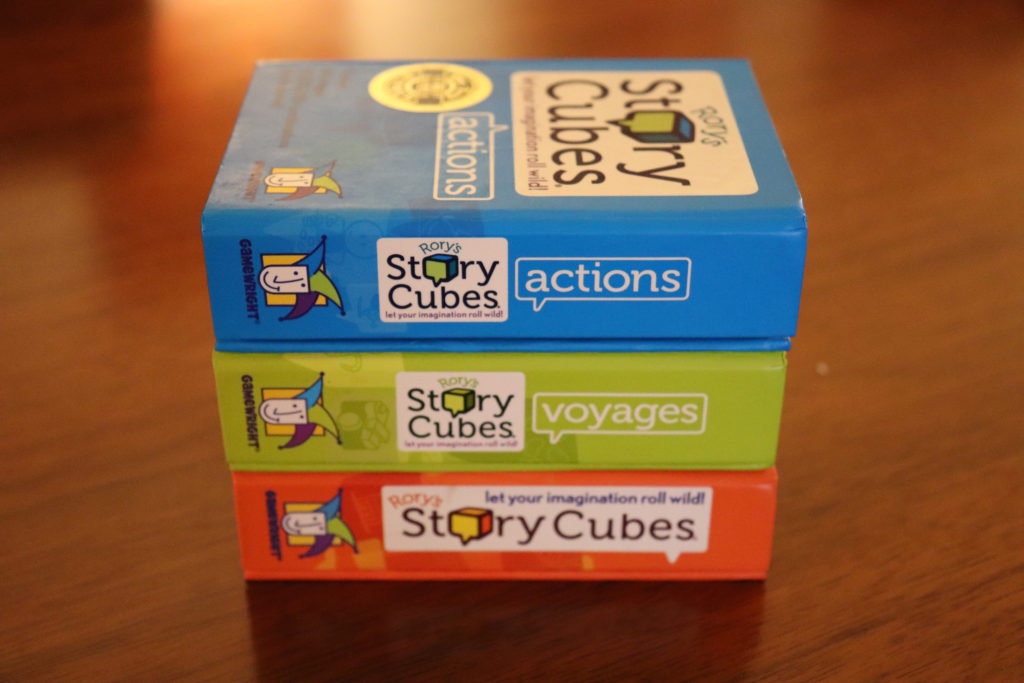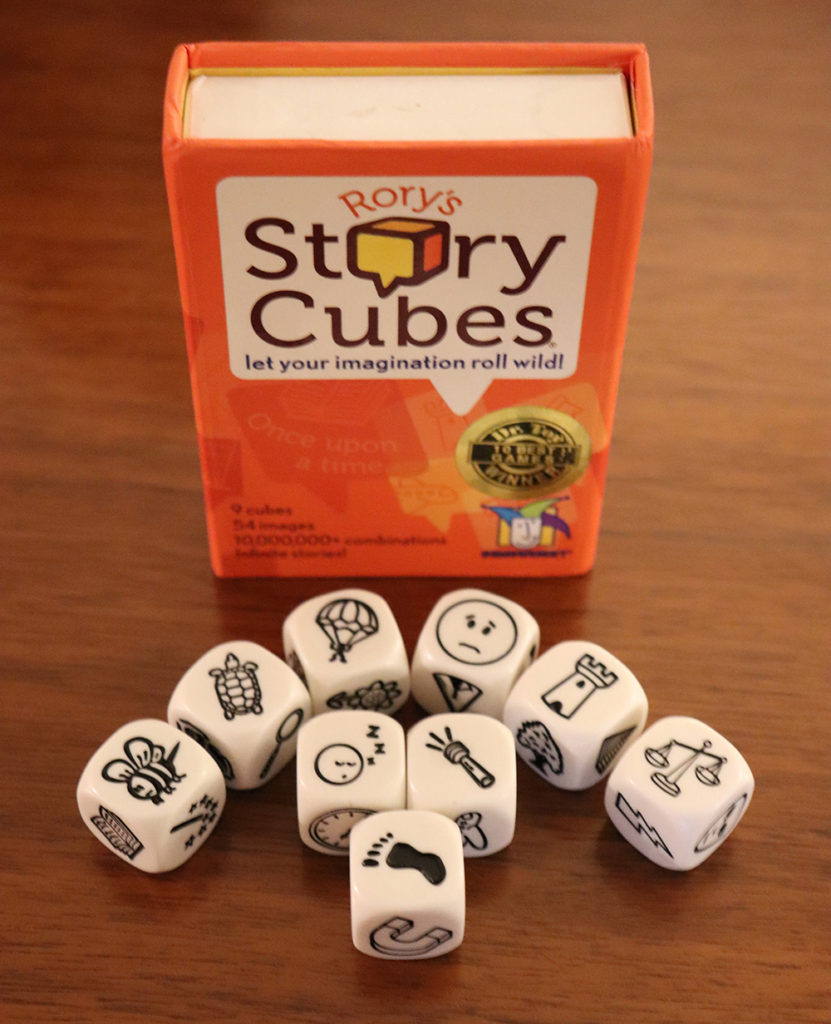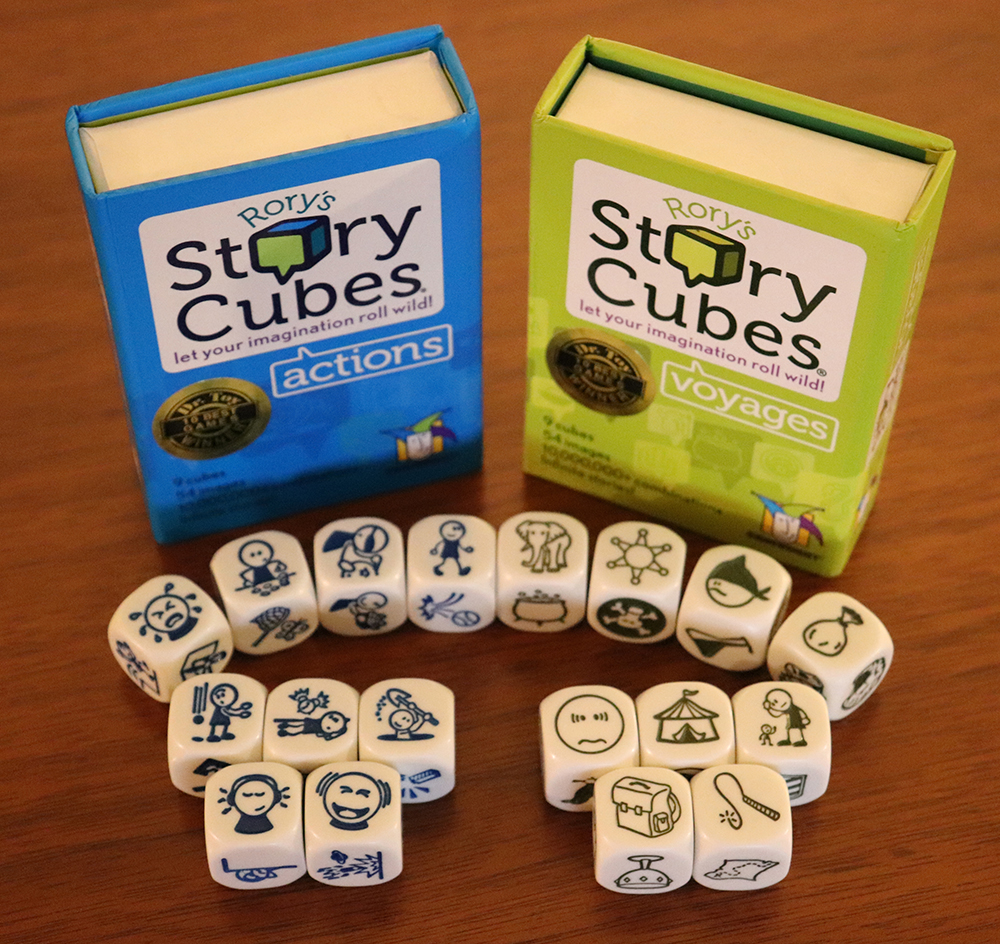
Rory’s Story Cubes are fantastic tool for story prompts, world-building, and social activities. These six-sided dice have a personality of their own. Several options. Limitless possibilities!
If you’re someone with a creative hobby, chances are you often look for new ways to challenge yourself.
You could be a writer trying to stir up some writing prompts, or a table-top game master/dungeon master looking to inspire the next session. Perhaps you’re a teacher with young students seeking an activity to stimulate their imagination and enhance their vocabulary. Theatre and improv might be your talent of choice. Team-building and collaboration might be in your job description.
Maybe you’re a long time creative with specific passions, and a treasure chest full of tools, materials, resources, toys, and other knick-knacks. Y’know! Like me.
Today, I want to talk about one of those toys! … Rory’s Story Cubes
I’ve had these around my space for the past year and a half, and have found myself using them in all sorts of interesting situations! Trust me; they’re really quite handy!
What are Story Cubes?

Rory’s Story Cubes are based on a simple idea; different symbols spark the imagination in different ways! They can even inspire entire stories when thrown together!
These boxes contain a collection of 9 six-sided dice, with a symbol on each side. Each of these symbols represent an object, action, or idea. When you roll them, the results conjoin with other story cubes on order to tell a story, or inspire… well… pretty much anything!
A short story, novella, poem, a table-top campaign, character, event, feature of world-building, conflict or crisis. Some have even used them as a social ice-breaker, or for team-building sessions in a collaborative environment. Their uses are endless! … All you need to do is choose your dice, roll them, see what you get. From there, you’re free to piece their meanings together however you want.
Zygomatic studios (owned by Asmodee) describes their product as “a compass, a guide to invent the craziest and most wonderful stories”.
When you think about it, Story Cubes (almost) function in the same way as an ink-blot test would; the results of the roll can be taken literal, but can also be a projection of something conceptual that comes to mind when you see the result.
Many Stories to Tell. Many Dice to Roll.
When I grabbed Story Cubes, I thought of them as a “game supplement” or “story idea generator”. In fact, the design of each set intends to inspire specific concepts.
The base set consists of a selection of symbols which can be interpreted freely. These are designed to be ambiguous, as to allow the user to come up with different meanings when paired with other dice. In addition, the Voyages and Actions sets add some special flavor to your rolls.
Voyages focuses on items, locations, and objects which represent travel, discovery, or adventure. Actions are what it sounds like; a collection of symbols that represent an individual performing a number of motions, emotions, and actions.
If the original three sets just aren’t enough, and you need even more options, … also makes Fantasia, Mystery, Primal, Heroes, Astro, and Emergency.


How I've used Story Cubes.
I’ve gotten quite a number of uses out of this tool personally. They’ve been a helpful, and fun way to get some of the juices flowing!
- I’ve used them as a freely-interpreted writing prompt which I can piece together within a few paragraphs. These can be for practice, or kick off a small project.
- Features on an overland map depicting a fantasy world. Points of interest, geographic features, or towns/settlements to visit.
- I’ve come up with NPC or puzzle-based encounters for table-top games; An event within the players immediate environment that draws their attention, and allows them to act on the situation.
- Themes for specific rooms within a dungeon, depicting the obstacle, atmosphere, potential items to discover, strategy of the monsters within, and other key elements.
- Mind game to help me come up with ideas on the fly, and build up my improvisation skills.
In addition, Story Cubes pair best with a way to chart your ideas:
- Index cards, a pencil, and eraser.
- Notebook, or note-taking app.
- White board, or cork board.
- Laptop with MS Word or other writing software.
Many other uses for Story Cubes:
Combating Writers Block
Shake out those cobwebs and get back to putting words on that page! Story Cubes can help you get out of the funk, and into the flow of writing again.
Improv Storytelling
If you need ideas on the fly, roll for a topic to get your improvisational juices flowing. Let the symbols be your guide!
Party-Game
Whether you’re relaxing with friend, or entertaining just the right crowd, having another peer-to-peer source of entertainment is always handy!
Warm-Up Activities
Whether you are leading a group of adults (or children), and you need a way to break the ice, this tool can open up the room to conversation and team-building.
World-building Session
Need an extra feature on that map? Does your Kingdom need some cool places with an interesting history? Toss some cubes and jot down your ideas!
Character-building Session
Even a simple tool like Story Cubes can inspire characters with interesting backstories. What traits does your character have? What’s their motivation? Roll some ideas!
Literacy and Public Speaking
Teaching kids how to come up with their own stories? Looking to work on your class project? Need speech ideas for your Toastmasters meeting? Try out Story Cubes!
- Interested? Find them on Amazon, or check out their website here! https://www.storycubes.com/en/
Writing this article was a blast! … Done completely out of the passion for writers/creative tools.
In other words, Asmodee, Zygomatic, and Gamewright are not sponsoring this article, or myself. Hopefully I’ve inspired some of you to check them out, because they really are neat!
While you’re at it, check out some of the other tools I’ve used:
… and don’t forget to follow on Facebook, Instagram, Pinterest, and Subscribe to my mailing list!
- Axolotls, Genies, and Kaiju; a Quick TTRPG Zine Roundup #2 - May 19, 2025
- d100 City Encounters and Urban Sidequests - April 26, 2025
- Dirtbags! a Sci-Fi Shooter RPG: Gameplay Review! - March 23, 2025


